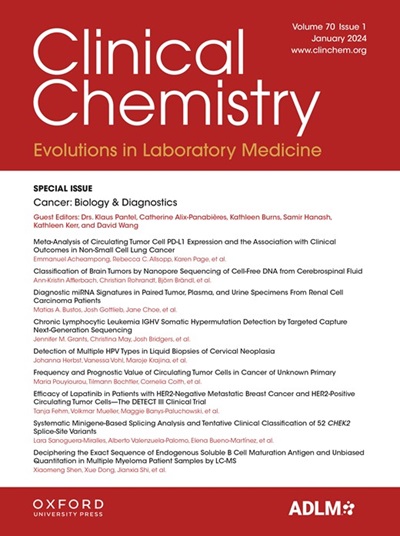B-005 提高了贝克曼库尔特 DxI 9000 免疫分析仪的灵敏度*,从而减少了免疫分析所需的样品和试剂量
IF 7.1
2区 医学
Q1 MEDICAL LABORATORY TECHNOLOGY
引用次数: 0
摘要
背景贝克曼库尔特 DxI 9000 免疫分析仪*采用了新技术,提高了检测灵敏度。这些先进技术包括 Lumi-Phos PRO 化学发光底物、新型发光仪和改进的低容量移液能力。这些改进为使用更少的样本和试剂量开发免疫测定提供了机会,从而节省了宝贵的患者样本,最大限度地减少了塑料包装的碳足迹,并增加了每包试剂的检测次数。本文介绍了对 Access TSH(第 3 IS)、Access βhCG(第 5 IS)和 Access Hybritech 总 PSA 检测方法的研究,以评估在 DxI 9000 分析仪上使用减少的样本/试剂量时的分析性能。*正式名称为 DxI 9000 Access 免疫分析仪。方法 为了评估与 Access 2 免疫测定系统的标准样品/试剂量相比,DxI 9000 分析仪使用按比例减少的样品/试剂量时的性能,按照 CLSI EP05-A3 评估了实验室内的精确度,按照 CLSI EP17-A2 估算了定量限 (LoQ),按照 CLSI EP09c 第三版评估了准确度。结果 下表总结了灵敏度研究的结果,与 Access 2 系统的标准容量相比,DxI 9000 分析仪使用的样本/试剂容量减少了。在 DxI 9000 分析仪上,尽管使用的样品/试剂减少了 50%,但观察到的最大 LoQ 提高了 1.4 到 3 倍。精确度和准确度研究也显示了可接受的性能。结论 本文提供的数据证明,在 DxI 9000 分析仪上使用减少的样品和试剂量进行检测时,仍能保持分析性能目标。DxI 9000 分析仪的额外灵敏度能力可用于减少样本和试剂量,从而节省病人样本并减少每次检测的包装。DxI 9000 分析仪的移液准确性和检测能力为免疫测定开发人员提供了提高低端性能和节约资源的机会。本文章由计算机程序翻译,如有差异,请以英文原文为准。
B-005 Improved Sensitivity on the Beckman Coulter DxI 9000 Immunoassay Analyzer* Enables Reduction of Required Sample and Reagent Volumes for Immunoassays
Background The Beckman Coulter DxI 9000 Immunoassay Analyzer* includes new technology that improves assay sensitivity capabilities. Such technological advancements include the Lumi-Phos PRO chemiluminescent substrate, a new luminometer, and improved low-volume pipetting capabilities. These enhancements afford opportunities to develop immunoassays using reduced sample and reagent volumes, conserving precious patient samples, minimizing the carbon footprint of plastic packaging, and increasing the number of tests per reagent pack. Studies are presented herein for the Access TSH (3rd IS), Access βhCG (5th IS), and Access Hybritech Total PSA assays to evaluate analytical performance when using decreased sample/reagent volumes on the DxI 9000 analyzer. *The official name is DxI 9000 Access Immunoassay Analyzer. Methods To assess performance when using proportionally reduced sample/reagent volumes on the DxI 9000 analyzer compared to standard sample/reagent volumes on the Access 2 Immunoassay System, within-laboratory precision was evaluated following CLSI EP05-A3, limit of quantitation (LoQ) was estimated following CLSI EP17-A2, and accuracy was assessed following CLSI EP09c, 3rd ed. Results Results of sensitivity studies are summarized in the table below for assays using reduced sample/reagent volumes on the DxI 9000 analyzer compared to standard volumes on the Access 2 system. Maximum observed LoQ improved 1.4- to 3-fold on the DxI 9000 analyzer, despite employing ∼50% reduction of sample/reagents. Precision and accuracy studies also showed acceptable performance. Conclusions The data herein provide evidence for maintained analytical performance goals when using reduced sample and reagent volumes for assays on the DxI 9000 analyzer. The additional sensitivity capability of the DxI 9000 analyzer can be used to reduce the volume of sample and reagents, conserving patient samples and reducing packaging per test. The pipetting accuracy and detection capabilities of the DxI 9000 analyzer provide opportunities for immunoassay developers to drive both improved low-end performance and conservation of resources.
求助全文
通过发布文献求助,成功后即可免费获取论文全文。
去求助
来源期刊

Clinical chemistry
医学-医学实验技术
CiteScore
11.30
自引率
4.30%
发文量
212
审稿时长
1.7 months
期刊介绍:
Clinical Chemistry is a peer-reviewed scientific journal that is the premier publication for the science and practice of clinical laboratory medicine. It was established in 1955 and is associated with the Association for Diagnostics & Laboratory Medicine (ADLM).
The journal focuses on laboratory diagnosis and management of patients, and has expanded to include other clinical laboratory disciplines such as genomics, hematology, microbiology, and toxicology. It also publishes articles relevant to clinical specialties including cardiology, endocrinology, gastroenterology, genetics, immunology, infectious diseases, maternal-fetal medicine, neurology, nutrition, oncology, and pediatrics.
In addition to original research, editorials, and reviews, Clinical Chemistry features recurring sections such as clinical case studies, perspectives, podcasts, and Q&A articles. It has the highest impact factor among journals of clinical chemistry, laboratory medicine, pathology, analytical chemistry, transfusion medicine, and clinical microbiology.
The journal is indexed in databases such as MEDLINE and Web of Science.
 求助内容:
求助内容: 应助结果提醒方式:
应助结果提醒方式:


